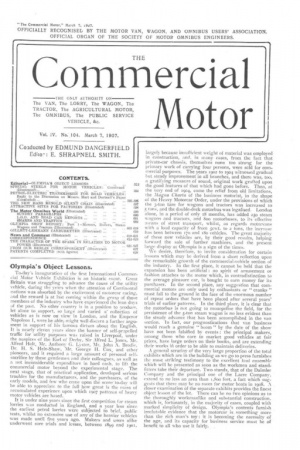Olympia' s Object Lessons.
Page 1

If you've noticed an error in this article please click here to report it so we can fix it.
To-day's inauguratiee of the first International Commercial Motor Vehicle Exhibition is an historic event. Great Britain was struggling to advance the cause of the. utility vehicle, during the rears when the attention of Continental nations was absorbed by the exciiement of motorcar racing, 4ind the reward is at last coming within the grasp of those members of the industry who have experienced the lean days of the past. No other country is in a position to produce, let alone to support, so large and varied a collection of vehicles as is now on view in London, and the Emperor Napoleon I, were he able; .might well discern a further argument in support of his famous dictum about the English. It is nearly eleven years since the banner of self-propelled traffic for utility purposes was raised in Liverpool, under the auspices of the Earl of Derby, Sir Alfred L. Jones, Mr. Alfred Holt, Mr. Anthony G. I..ster, Mr. John A. Brodie, Dr, H. S. Hele-Shaw, Mr. George H. Cox, and other pioneers, and it required a large amount of personal selfsacrifice by these gentlemen and their colleagues, as well as a not inconsiderable expenditure in hard cash, to lift the t ommercial motor beyond the experimental stage. The next stage, that of practical application, developed serious troubles for the manufacturers, and the purchasers, of the early models, and few who come upon the seene'to-dav will be able to appreciate. to the full how great is the mass of accumulated experience upon which 1907 patterns of heavy motor vehicles are based.
It is under nine years since the first competition for steam lorries was conducted in Etigland, and a year less since. the earliest petrol lorries were subjected to brief, public tests, whilst no extensive use of any of the heavier vehicles was made until five years ago. Makers and users alike underwent sore trials and losses, between 1899 and 1901, largely because insufficient weight of material was employed in construction, end, in many cases, from the fact that private-car chassis, themselves none too strong for the primary work of carrying four persons, were sold for commercial purposes. The years 1902 to 19(4 witnessed gradual but steady improvement in all branches, and there was, too, e gratifying measure of sound, original work grafted upon the good features of that which had gone before. Then, at the very end of 1904, came the relief from old limitations, the Magna Charla of the business motorist, in the shape of the Heavy Motorcar Order, under the provisions of which the 3-ton tare for wagons and tractors was increased to 5 tons, and the double-deck motorbus was legalised. London alone, in a period of only i8 months, has added 250 steam wagons and tractors, and Soo motorbuses, to its effective :Peens. of street transport, whilst, as regards motorvans with a load capacity of from scwt. to 2 tons, the increase has been between 170 and 18o vehicles. The great majority of these new vehicles are, by their good results, helping forward the sale of further machines, and the present large display at Olympia is a sign of the times.
We desire, therefore, to invite consideration for certain lessons which may be derived from a short reflection upon the remarkable growth of the commercial-vehicle section of the industry. In the lirst place, it cannot be held that the expansion has been artificial : no spirit of amusement or fashion attaches to the motor which, in contradistinction to the average pleasure car, is bought to earn money for its purchaser. In the second place, any suggestion that commercial motors are only used by enthusiasts or "cranks " must fall to the ground in the face of the enormous number of repeat orders that have been placed after several years' trials of earlier patterns. In the third place, it is clear that the motorbus is not going to monopolise the field, for the persistence of the 5-ton steam wagon is no less evident than the steady advance that has been accomplished in the van section. In fact, our prognostications that van business would reach a genuine " boom " by the date of the show have not been falsified by events : the principal makers, among those who care to market good vehicles at fair prices, have large orders on their books, and are extending their works iii order to be able to maintain deliveries.
A general scrutiny of the very large proportion of the total exhibits which are in the building as we go to press furnishes the most striking testimony to the excellent tout ensemble which will be presented as soon as the workmen and stand. fitters take their departure. Two stands, that of the Daimler Company and the principal one of the Lacre Company, extend to no less an area than 1,800 feet, a fact which suggests that there may be no room for motor boats in 1908. A closer examination of the separate exhibits provides the finest object lesson of the lot. There can be no two opinions as to the thoroughly workmanlike and substantial construction, which is, fortunately, in the majority of cases, coupled with marked simplicity of design. Olympia's contents furnish irrefutable evidence that the motorcar is something more than the rich man's toy : it is becoming the necessity of the age, and its capacity for business service must be of benefit to all who use it fairly. .








































